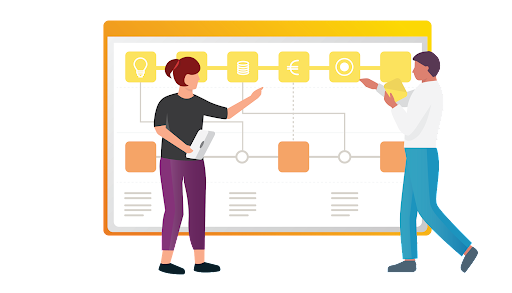Service design consists of mentality, tools and methods that span your entire organization – including yourself! But don’t worry, you do not have to be a Service Designer or a know-it-all in customer experience.
All you need to do is understand what service design means for you and your work. And in this blog post we have summarized all you need to know. Here are the fundamentals of service design - a crash course for everyone.
Why you need to know about service design in the first place
Simply because present day’s competition is held between companies that offer the best user or buyer experience. This is not possible without the participation of the entire organization.
If your organization has its own Service Designer, it is easy to just dump the task of designing user-friendly products and services on them. If you are inclined to say that “I just write code ”, “I reply to support requests” or “I lead people,” it may seem frustrating to fuss over some newish trend such as service design.
But the truth is that the market is won with customer-oriented productization, and it is only achievable if everyone has the same understanding of your goals. No one in the company is solely responsible for the outcome of service design: the customer experience. Put another way: everyone is equally responsible for the experience. The Service Designer enables the activity but does not own it.
Customer-oriented thinking or an organization emphasizing service quality are not possible without the participation of the entire organization. That is why service design is the responsibility of everyone, including you.
How does service design affect your work in practice?
The basic idea of service design is to contemplate your work and actions from the perspective of the customer. What significance and benefit does your work provide to the customer? And what does it enable?
t may be a relief to know that it is enough to think of your colleague as your customer - an internal customer whose work you want to make easier. Perhaps you will help your colleague do something that facilitates someone’s work with a customer. How can you help your customer – end customer and/or colleague – make progress in their work?
What you can do to improve the user/buyer experience
Discuss with the team, who the internal and external customers are. This contemplation can be facilitated and concretized with the help of a stakeholder map and personas. It is important to compile the data you already have on customers as well as gather more data using various methods to gain proper customer insights.
Next step is to figure out the journey of the chosen customer or persona, once you have them defined. The customer journey is the path that the customer takes before, during and after entering the service.
- How does the customer find your service?
- What happens during the time that the customer is in contact with the service?
- What are the touchpoints?
Consider this from both the customer’s and your own perspective.
- At which point and why will the customer end their cooperation with you?
- Will they smoothly continue on with the matter elsewhere, stop completely or come to your service again?
After this, it is only logical to recognize those touchpoints where the customer struggles and where you can delight them. The chasms, where the customer is unsatisfied, you naturally fix. The more you can delight the customer on his journey, the better customer experience you provide. Assess at which touchpoints you could make the customer’s experience better and how you could surprise them positively. After all, don’t you aspire to provide a positive customer experience?
When you know who your customers are and how they behave, it is time to contemplate what the team – and everyone individually – could do together to promote satisfaction and functionality in practice.
In summary: Service design simplified
- Consider who your customer (whom you are working for) is. Turn this image into a persona, an archetype of a typical customer, and compile all their needs, wishes, benefits and worries.
- Consider the customer journey with its touchpoints. How does the customer or persona enter your service? What happens during and what happens after he leaves the service? This is best visualized.
- Assess how you could make the customer experience better. Recognize (visualize on the map) where to delight the customer and what to fix to ensure better customer experience.
… and you will get far.
Published: Mar 2, 2022



